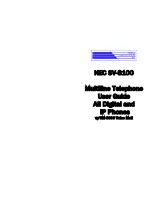
and installers using this technology for calls to or
from the PSTN refer to ITU E Model requirements
in the design of their networks. The overall aim is to
minimise delay, distortion and other transmission
impairments, particularly for those calls involving
cellular and international networks, which already
suffer extensive delay.
Echo cancellation
•
Echo cancellers are not normally required in the
Telecom PSTN because geographic delays are
acceptable where CPE return loss is maintained
within Telepermit limits. However, those private
networks making use of Voice over IP technology
are required to provide echo cancellation for all
voice calls. The combined effect of audio / VoIP
conversion delay and IP routing delay can cause
the echo cancellation time of
³
64 mS to be
required.
PTC200 6.11.1 (3) All Customer Equipment (fail
safe requirements)
•
Under power failure conditions this appliance may
not operate. Please ensure that a separate
telephone, not dependent on local power, is
available for emergency use.
For users in Singapore only
For users in Hong Kong only
For Best Performance
Operating Range
•
The range of operation depends on the topography
of your office, weather, or usage conditions,
because signals are transmitted between the CS
and the handset by radio waves.
•
Normally, you get greater range outdoors than
indoors. If there are obstacles such as walls, noise
may interfere with your telephone calls. In
particular, high metal shelves or reinforced concrete
walls will restrict your operating range.
•
A handset may not work when it is too far from the
CS depending on the structure of the building.
•
We strongly suggest you hold the bottom half of the
handset to ensure better call quality. Because, the
antenna is located in the upper half of the handset.
Noise
Occasional noise or interference may occur due to
electromagnetic radiation from objects such as
refrigerators, microwave ovens, faxes, TVs, radios, or
personal computers. If noise disturbs your telephone
calls, keep the handset away from these electrical
appliances.
Environment
•
Keep the product away from heating appliances
and devices that generate electrical noise, such as
fluorescent lamps and motors. These noise sources
can interfere with performance of the product.
•
Do not place the product in rooms where the
temperature is less than 0 °C or greater than 40 °C.
•
Allow 10 cm clearance around the product for
proper ventilation.
•
Avoid environments with excessive smoke, dust,
moisture, mechanical vibration, shock, or direct
sunlight.
•
The apparatus is designed to be installed and
operated under controlled conditions of ambient
temperature and a relative humidity.
Routine Care
•
Unplug the charger from the AC outlet before
cleaning.
•
Wipe the product with a soft cloth.
•
Do not clean the product with abrasive powder or
with chemical agents such as benzine or thinner.
•
Do not use liquid cleaners or aerosol cleaners.
•
Clean the terminal of the charger periodically.
Document Version 2012-11
Operating Instructions
11
Important Information












































